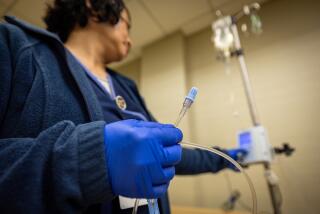One of the most promising drugs for Alzheimer’s disease fails in clinical trials

To the roughly 400 clinical trials that have tested some experimental treatment for Alzheimer’s disease and come up short, we can now add three more.
An experimental drug called idalopirdine failed to help people with mild to moderate Alzheimer’s disease in a trio of trials that involved 2,525 patients in 34 countries. Not only did the drug fail to bring about any meaningful change in cognitive tests that are widely used in diagnosing and tracking the progress of the disease, it also failed to cause significant improvements in general measures of daily function among those taking it at any of three tested doses.
Those are relatively modest goals — not to reverse Alzheimer’s disease or block its progress, but simply to slow the loss of function in those who have it. Even that, it turns out, is a humbling challenge.
The failure of idalopirdine, reported Tuesday in the Journal of the American Medical Assn., probably marks the unraveling of an approach to Alzheimer’s treatment that has long looked promising.
The experimental drug largely acted to increase the supply of the brain chemical serotonin, which, among other things, regulates mood, sleep and appetite, and ebbs in those with Alzheimer’s disease. Idalopirdine also acts on four other neural transmitters that are affected by Alzheimer’s: glutamate, norepinephrine, acetylcholine and dopamine.
The drug had looked promising in earlier clinical trials that focused largely on safety. But after 24 weeks, subjects with Alzheimer’s who got idalopirdine fared no better than those who got a sham drug.
The disappointing results follow the failure, reported last fall, of intepirdine, another experimental drug that acted on many of the same brain systems as idalopirdine.
Subjects in both trials also took donepezil (long marketed as Aricept) or another Alzheimer’s drug in the same class. Researchers had hoped that the combination therapy might boost the action of several different neurotransmitter systems at once to improve mental function in Alzheimer’s patients.
Lundbeck, the publicly traded Danish pharmaceutical company that was developing idalopirdine, told investors last year that it would not be asking the Food & Drug Administration to evaluate the drug for the U.S. market. That would have been the next step if the phase 3 trials had succeeded.
As researchers and government officials have focused on ambitious efforts to reverse or even cure Alzheimer’s, doctors have appealed for therapies that will at least improve the lives of the 5.5 million Americans already living with the disease.
Yet the new results underscore the diabolical challenge of merely slowing Alzheimer’s disease once its behavioral symptoms become evident, according to Dr. David A. Bennett, a neurologist and director of Rush University’s Alzheimer’s Disease Center in Chicago.
Given the millions of Americans already afflicted, “better symptomatic therapies must continue to be pursued,” Bennett wrote in an editorial also published in JAMA. “However, from a public health perspective, delaying the onset of Alzheimer disease dementia is the most effective approach to reduce the overall human and economic toll of the disease.”
That, he wrote, will require earlier diagnosis of Alzheimer’s among a broader range of people, including people with no outward sign of dementia. And those in the disease’s earliest phases will need to be enrolled in clinical trials of preventive strategies faster, and in larger numbers.
A public hungry for quick fixes and streamlined drug development had better get patient, Bennett added. Citing a recent exploration of why so many Alzheimer’s disease drugs fail, he noted that treatments that could halt or reverse Alzheimer’s might need to be tested for five to 10 years for an effect to be detected. Currently, few such trials last for more than three years.
And maybe, Bennett added, we’re not seeing that we’re on a trajectory — albeit a long one — to eventual success.
“Given the series of failures in rigorous attempts to develop an effective treatment for Alzheimer disease, it may seem difficult to be optimistic,” he wrote. “Yet lessons from the past century paint a different picture.”
With a request for $100 million in added funds for cancer research in 1971, President Nixon began a process of investment and discovery that has brought forth treatments for cancer that were beyond imagination at the time. In 2011, President Obama launched the National Alzheimer’s Project Act with an initial investment of $50 million. By 2017, federal research on Alzheimer’s disease had reached $1.4 billion.
“It is just a matter of time before that knowledge is translated into effective strategies for the treatment and prevention” of Alzheimer’s, Bennett wrote.
And none too soon: The Alzheimer’s Assn. estimates that an American is newly diagnosed with the disease every 66 seconds.
MORE IN SCIENCE
This USC physicist wants you to talk about science. His new graphic novel can get you started
Banning seven words at the CDC would have at least seven serious consequences for public health
Why the United States is ‘the most dangerous of wealthy nations for a child to be born into’







